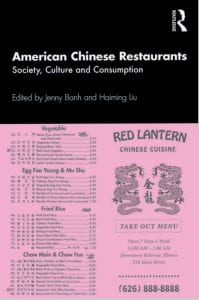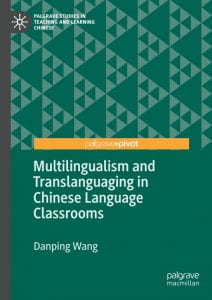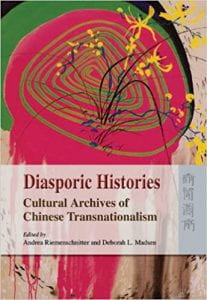American Chinese Restaurant: Society, Culture and Consumption is a collection of ethnographic case studies on American Chinese restaurants and personal stories of people who started, worked at, and/or grew up in this business. The essay contributors come from various backgrounds to introduce Chinese restaurants as “dynamic agencies,” inviting readers to ponder on issues including identity, ethnicity, transnationalism, assimilation, and socioeconomic differences. Editors Jenny Banh and Haiming Liu group the essays into five major categories and present them in ways that will interest readers of any background.
is a collection of ethnographic case studies on American Chinese restaurants and personal stories of people who started, worked at, and/or grew up in this business. The essay contributors come from various backgrounds to introduce Chinese restaurants as “dynamic agencies,” inviting readers to ponder on issues including identity, ethnicity, transnationalism, assimilation, and socioeconomic differences. Editors Jenny Banh and Haiming Liu group the essays into five major categories and present them in ways that will interest readers of any background.
The first part of the book addresses the topic of social analysis. In “Creating and Negotiating ‘Chineseness’ through Chinese Restaurants in Santiago, Chile,” Carol Chan and Maria Montt Strabucchi explore the “dynamic relations between migration, race, the restaurant industry, and national identity in Santiago” (20). Deriving from the interviews with people who run and/or work in Chinese restaurants, Chan and Strabucchi discuss how the people’s Chilean and Chinese identities were expressed and challenged in their communities. Similarly, Patricia Palma and José Ragas’s essay “Feeding Prejudices: Chinese Fondas and the Culinary Making of National Identity in Peru” also raises the issue of identity, particularly the relationship between Chinese restaurants, prejudice, and national identity. This chapter explains how Chinese diaspora and their businesses, especially the chifas (Peruvian-Chinese restaurants) and fondas (small restaurants), continued growing despite opposition from society.
Two essays in the first part of the book analyze the Southeast Asian communities living in Los Angeles and focus on the Chinese donut restaurateurs' practices and strategies to deal with economic issues. Francis Huynh’s “From Chinese Donuts to Leek Cakes: Navigating Los Angeles Chinatown’s Golden Waters” studies Kim Chuy, a Teochew-style restaurant, that had a major influence on the identity formation for the diasporic Teochew community in the United States. Huynh analyzes how the restaurant dealt with economic challenges (e.g., gentrification) and accommodated the growing diversity of customers and workers. Erin Curtis’s “Selling Donuts in the Fragmented Metropolis: Chinese Cambodian Donut Shops in Los Angeles and the Practices of Chinese Restaurants” explores the strategies and practices that helped Chinese Cambodian donut shops succeed in the United States restaurant industry.
In the last essay of this section, “Talk Doesn’t Cook Rice: Chinese Restaurants and the Chinese (American) Dream in Ohio,” Anthony Miller discusses how Chinese restaurant owners in Ohio attempt to present authentic Chinese food to the community without provoking prejudice against Chinese due to the rise of China’s economy. At the same time, Miller also looks at these restaurateurs' struggles and strategies to succeed in the US restaurant industry.
The second part of the book addresses the topic of culinary histories. In “Surveying the Genealogy of Chinese Restaurant in Mexico: From High-End Franchises to Makeshift Stands,” Yong Chen considers the question of what restaurants can be categorized as Chinese restaurants. He decides to take an inclusive approach by “count[ing] the Mexican-owned ‘Chinese restaurants’ as equally belonging to the general category, and … not [being] concerned with the question of what is ‘authentic’ Chinese food” (89). From his research, he came up with four groups of Chinese restaurants in Mexico, namely the restaurant chains from the United States (e.g., Panda Express), the restaurants intended for people with a Chinese palate, the restaurants catered to the general public, and the restaurants run by Mexicans who once worked in Chinese restaurants in the United States.
Oliver Wang’s “Live at the China Royal: A Funky Ode to Fall River’s Chow Mein Sandwich” discusses the history of Chow Mein Sandwich in Fall Rivers, Massachusetts. Wang highlights the significance of the chow mein sandwich that was considered a “fusion” dish in the Asian Pacific Islander communities.
David Wu’s “Under the Banner of Northern Chinese Cuisine: Invention of the Pan-China Cuisine in American Chinese Restaurants” shares the stories of two successful “Northern Chinese” restaurants. The stories explain the origin of the late twentieth-century “Northern Chinese” dish and how it eventually became known as “Pan-China Cuisine” in most American Chinese restaurants. The history of these restaurants reflects the story of Chinese and Taiwanese diaspora in the United States.
In the essay “Oriental Palaces: Chin F. Foin and Chinese Fine Dining in Exclusion-Era Chicago,” Samuel King explores the story of a famous Chinese restaurateur who established luxurious Chinese restaurants catering to middle- and upper-class white diners. This way, he showed that he was of the “better element” of the Chinese Americans in Chicago, allowing his family and himself to be better accepted by the dominant Americans.
Haiming Liu’s “Chop Suey, P.F. Chang’s, and Chinese Food History in America” examines the role of chop suey and P.F. Chang’s in the American Chinese culinary history. Chop suey was indeed a major contributor to the popularity of Chinese cuisine in America as it attracted even the famous President Eisenhower. P.F. Chang’s has also been successful in promoting Chinese cuisine, although Liu argued that “it was unrelated to Chinese American identity and culture” (165).
The third part of Banh and Liu’s book contains person-centered narratives. Jacob R. Levin’s “Chinese Restaurants and Jewish American Culture” explains how generations of his Jewish family and other Jewish Americans interacted with Chinese food that it became the “‘most Jewish’ of the ‘non-Jewish’ foods in Jewish American culture” (174). Meanwhile, Cheuk Kwan’s “Last Tango in Argentina” is a first-person account of Kwan’s Chinese restaurant in Argentina, in which he shares his experience meeting Foo-Ching Chiang, a Chinese restaurateur.
Moreover, Jenny Banh contributes three essays in this section. In the “Chinese Restaurant Kids Speak about Labor, Lifeways, and Legacies,” Jenny Banh shares her personal experiences with her immigrant family, describing the experiences she had and life lessons she learned as she grew up working in a Chinese restaurant. “Chinese American Chef Ming Tsai Life of East and West Hybridity” and “Culinary Ambassador Chef Martin Yan Speaks Life, Authenticity, and the Future of Chinese Restaurants” present interviews with Chef Ming Tsai and Chef Martin Yan. In these interviews, the chefs shared their migration stories as well as experiences in running their own Chinese restaurants and food television shows.
The fourth and fifth parts of the book are related to visuals. Part four is a unique collection of comics which highlight events from the everyday life of owners, workers, and customers of Chinese restaurants. Part five analyzes real photos and building environments of certain Chinese restaurants.
The fifth part of the book opens with Nicholas Bauch and Rick Miller’s “A Visual Habitat Study for Chinese Restaurants in a California Conurbation.” This chapter analyzes the neighborhood surrounding the “Chinese food mecca” in San Gabriel Valley, CA. The photographs show the local area that plays an important role in supporting the economy of these Chinese restaurants.
Christopher Sullivan’s “Redefining and Challenging the Boundaries of Chinese Cuisine: A Visually Based Exploration of Uyghur Restaurants in the United States” introduces the Uyghur cuisine, which came from a Turkic Muslim population that lives in Xinjiang province, Northwest of China. The Uyghur cuisine challenges Americans to expand their definition of Chinese cuisine.
The last two essays touch on political and racial issues. Lily Cho’s “Diasporic Counterpublics: The Chinese Restaurant as Institution and Installation in Canada” examines how a Canadian Chinese restaurant became the “diasporic counterpublic” for Chinese Canadian communities. Cho defines “counterpublic” as “a community that exists as a counter to a dominant or mainstream community” (283). In a similar vein, Hongyan Yang’s “Toy’s Chinese Restaurants: Exploring the Political Dimension of Race through the Built Environment” analyzes the history and built environment of Toy’s restaurants in Milwaukee, Wisconsin, particularly their racial representations of Chinese.
American Chinese Restaurant: Society, Culture and Consumption presents various research essays, personal stories, comics, and photographs of Chinese restaurateurs and restaurants. The book invites us to see the realities, joys, and struggles of the American Chinese diaspora. Banh and Liu effectively showcase the essays in ways that will surely attract readers and scholars who are interested in the significant relationships between food and cultural identity.


































